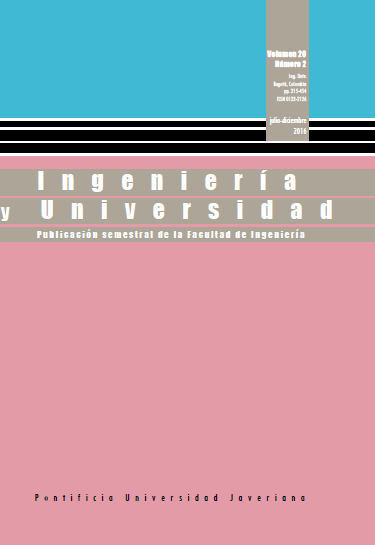Abstract
This paper shows a modification of the traditional ‘perturb and observe’ algorithm used to the maximum power point tracking in photovoltaic systems. The proposal is justified by the need of algorithms to track the global máximum power point in solar panels connected in series under partially shaded conditions. The proposal tracks the global maximum power point avoiding the previous iterative search in local maximums. The algorithm performance is evaluated by simulations in the software PSIM and its behavior is compared with the traditional perturb and observe algorithm. The results show the outstanding performance of the modified algorithm in the tracking of the global maximum power point under different non uniform conditions of temperature and irradiance in the solar array.
[2] B. Bendib, H. Belmili, and F. Krim, “A survey of the most used MPPT methods: conventional and advanced algorithms applied for photovoltaic systems,” Renew. Sust. Energ. Rev., vol. 45, no. 1, pp. 637-648, 2015. [Online]. Available: http://www.sciencedirect.com/science/article/pii/S1364032115000970
[3] M. A. G de Brito, L. Galotto, L. P Sampaio, G. de Azevedo, and C. A. Canesin, “Evaluation of the main MPPT techniques for photovoltaics applications,” IEEE Trans. Ind. Electron., vol. 60, no. 3, pp. 1156-1167, 2013. [Online]. Available: http://ieeexplore.ieee.org/stamp/stamp.jsp?tp=&arnumber=6196220
[4] S. S. W. Walker, N. K. Sooriyaarachchi, N. D. B. Liyanage, P. A. G. S. Abeynayake, and S. G. Abeyratne, “Comparative analysis of speed of convergence of MPPT Techniques,” in 2011 6th IEEE Int. Conf. Ind. Inf. Syst. (ICIIS), 2011, pp. 522-526. [Online]. Available: http://ieeexplore.ieee.org/stamp/stamp.jsp?tp=&arnumber=6038125
[5] M. A. G. de Brito, L. Galotto, L. P. Sampaio, G. de Azevedo, and C. A. Canesin, “Comparative analysis of MPPT techniques for PV applications,” in 2011 Int. Conf. Clean Electr Power (ICCEP), 2011, pp. 99-104.
[6] H. Rezk and A. M. Eltamaly, “A comprehensive comparison of different MPPT techniques for photovoltaic systems,” Solar Energy, vol. 112, no. 1, pp. 1-11, 2015. [Online]. Available: http://www.sciencedirect.com/science/article/pii/S0038092X14005428
[7] M. A. Eltawil and Z. Zhao, “MPPT techniques for photovoltaic aplications,” Renew. Sust. Energ. Rev., vol. 25, no. 1, pp. 1-11, 2013. [Online]. Available: http://www.sciencedirect.com/science/article/pii/S1364032113003250
[8] A. Dolara et al., “Energy comparison of seven MPPT Techniques for PV Systems,” J. Electromagnet Anal. Appl., vol. 1, no. 3, pp. 152-162, 2009. [Online]. Available: http://www.scirp.org/journal/PaperInformation.aspx?PaperID=725
[9] A. Al-Diab and C. Sourkounis, “Variable step size P&O MPPT algorithm for PV systems,” in 2010 12th Int. Conf. Optim. Elect. Electron. Equipment (OPTIM), 2010, pp. 1097-1102.
[10] M. A. Abdourraziq, M. Ouassaid, M. Maaroufi, “Comparative study of MPPT using variable step size for photovoltaic systems,” in 2014 Second World Conference on Complex Systems (WCCS), 2014, pp. 374-379.
[11] F. A. O. Aashoor and F. V. P. Robinson, “A variable step size perturb and observe algorithm for photovoltaic maximum power point tracking,” in 2012 47th Int. Univ. Power Eng. Conf. (UPEC), 2012, pp. 1-6.
[12] M. Hassani, S. Mekhilef, A. P. Hu, N. R. Watson. “A novel MPPT algorithm for load protection base on output sensing control,” in 2011 IEEE Ninth Int. Conf. Power Electron. Drive Syst. (PEDS), 2011, pp. 1120-1124 [Online]. Available: http://ieeexplore.ieee.org/stamp/stamp.jsp?tp=&arnumber=6147400
[13] A. Sayal, “MPPT techniques for photovoltaic system under uniform insolation and partial shading conditions,” in 2012 Students Conf. Eng. Syst. (SCES), 2012, pp. 1-6.
[14] R. Alonso, P. Ibáñez, V. Martínez, E. Ramón, and A. Sanz, “An innovative perturb, observe and check algorithm for partially shaded PV systems,” in 13th Eur. Conf. Power Electron. Appl., 2009, pp. 1-8.
[15] E. Durán, M. Sidrach, J. Galán, and J. M. Andujar, “Comparative analysis of buck-boost converters used to obtain I-V characteristic curves of photovoltaic modules,” in IEEE Power Electron. Specialist Conf., 2008, pp. 2036-2042.
[16] S. J. Chiang, H. Shieh, and M. Chen, “Modeling and control of PV charger system with SEPIC converter,” IEEE Trans. Ind. Electron., vol. 56, no. 11, pp. 4344-4353, 2009. [Online]. Available: http://ieeexplore.ieee.org/stamp/stamp.jsp?tp=&arnumber=4631374
[17] M. Marodkar, S. Adhau, M. Sabley, and P. Adhau, “Desing and simulation of DC-DC converters for photovoltaic system based on Matlab,” in 2015 Int. Conf. Ind. Instru. Control (ICIC), 2015, pp. 1478-1483.
[18] M. Killi and S. Samanta, “Output voltage sensor based maximum power point tracking for PV system using SEPIC,” in 2015 IEEE Int. Conf. Ind. Technol. (ICIT), 2015, pp. 1112-1116.
[19] R. F. Coelho et al., “Analytical and experimental analysis of DC-DC converters in photovoltaic maximum power point tracking applications,” in 36th Ann. Conf. on IEEE Ind. Electron. Soc. (IECON(, 2010, pp. 2778-2783.
[20] J. J. Nedumgatt et al., “Perturb and observe MPPT algorithm for solar PV systems –modeling and simulation,” in 2011 Ann. IEEE India Conf. (INDICON), 2011, pp. 1-6.
[21] L. Hassaine, “Implementación de un control digital de potencia activa y reactiva para inversores: aplicación de sistemas fotovoltaicos conectados a la red,” Ph.D. dissertation, Departamento de Tecnología Electrónica, Universidad Carlos III de Madrid, Leganés, España, 2010.
This journal is registered under a Creative Commons Attribution 4.0 International Public License. Thus, this work may be reproduced, distributed, and publicly shared in digital format, as long as the names of the authors and Pontificia Universidad Javeriana are acknowledged. Others are allowed to quote, adapt, transform, auto-archive, republish, and create based on this material, for any purpose (even commercial ones), provided the authorship is duly acknowledged, a link to the original work is provided, and it is specified if changes have been made. Pontificia Universidad Javeriana does not hold the rights of published works and the authors are solely responsible for the contents of their works; they keep the moral, intellectual, privacy, and publicity rights.
Approving the intervention of the work (review, copy-editing, translation, layout) and the following outreach, are granted through an use license and not through an assignment of rights. This means the journal and Pontificia Universidad Javeriana cannot be held responsible for any ethical malpractice by the authors. As a consequence of the protection granted by the use license, the journal is not required to publish recantations or modify information already published, unless the errata stems from the editorial management process. Publishing contents in this journal does not generate royalties for contributors.


